
Newark Castle, Port Glasgow
Encyclopedia

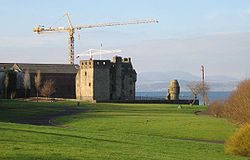
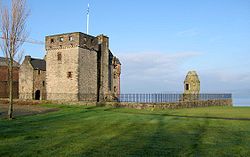
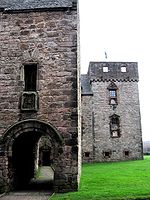
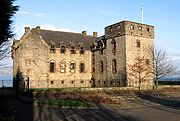
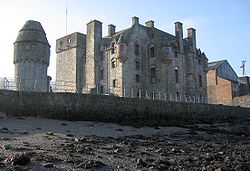

Castle
A castle is a type of fortified structure built in Europe and the Middle East during the Middle Ages by European nobility. Scholars debate the scope of the word castle, but usually consider it to be the private fortified residence of a lord or noble...
sited on the south shore of the estuary
Estuary
An estuary is a partly enclosed coastal body of water with one or more rivers or streams flowing into it, and with a free connection to the open sea....
of the River Clyde
River Clyde
The River Clyde is a major river in Scotland. It is the ninth longest river in the United Kingdom, and the third longest in Scotland. Flowing through the major city of Glasgow, it was an important river for shipbuilding and trade in the British Empire....
in Port Glasgow
Port Glasgow
Port Glasgow is the second largest town in the Inverclyde council area of Scotland. The population according to the 1991 census for Port Glasgow was 19426 persons and in the 2001 census was 16617 persons...
, Inverclyde
Inverclyde
Inverclyde is one of 32 council areas used for local government in Scotland. Together with the Renfrewshire and East Renfrewshire council areas, Inverclyde forms part of the historic county of Renfrewshire - which current exists as a registration county and lieutenancy area - located in the west...
, Scotland
Scotland
Scotland is a country that is part of the United Kingdom. Occupying the northern third of the island of Great Britain, it shares a border with England to the south and is bounded by the North Sea to the east, the Atlantic Ocean to the north and west, and the North Channel and Irish Sea to the...
, where the firth
Firth
Firth is the word in the Lowland Scots language and in English used to denote various coastal waters in Scotland and England. In mainland Scotland it is used to describe a large sea bay, or even a strait. In the Northern Isles it more usually refers to a smaller inlet...
gradually narrows from the Firth of Clyde
Firth of Clyde
The Firth of Clyde forms a large area of coastal water, sheltered from the Atlantic Ocean by the Kintyre peninsula which encloses the outer firth in Argyll and Ayrshire, Scotland. The Kilbrannan Sound is a large arm of the Firth of Clyde, separating the Kintyre Peninsula from the Isle of Arran.At...
and navigation upriver is made difficult by shifting sandbanks. For centuries this location was used to offload seagoing ships, and led to the growth of Port Glasgow close to the castle on either side and to the south. When dredging techniques made the Clyde navigable as far as Glasgow the port became a shipbuilding centre, and the castle was surrounded by shipyards. Ferguson Shipbuilders
Ferguson Shipbuilders
Ferguson Shipbuilders Limited is a shipyard located in Port Glasgow on the River Clyde in Scotland. It is the last remaining shipbuilder on the lower Clyde, and is currently the only builder of merchant ships on the river - the company's mainstay has long been Roll-on/roll-off ferries.-History:The...
, the last shipyard on the lower Clyde, stands close to the west of the castle, but the shipyards to the east were removed around the 1980s and new landscaped areas formed to the east of Newark Castle, opening up scenic views of the castle and across the Clyde from a new bypass road.
History
The castle was built in 1478 by George MaxwellGeorge Maxwell
George Maxwell was a professional collector of plants and insects in Southwest Australia. The botanical specimens he obtained were used to make formal descriptions of the region's plant species....
when he inherited the Barony of Finlanstone (Finlaystone) in the parish of Kilmacolm
Kilmacolm
Kilmacolm is a village and civil parish in the Inverclyde council area and the historic county of Renfrewshire in the west central Lowlands of Scotland. It lies on the northern slope of the Gryffe Valley south-east of Greenock and around west of the city of Glasgow...
. The original castle had a tower house
Tower house
A tower house is a particular type of stone structure, built for defensive purposes as well as habitation.-History:Tower houses began to appear in the Middle Ages, especially in mountain or limited access areas, in order to command and defend strategic points with reduced forces...
within a walled enclosure or barmkin
Barmkin
Barmkin, also spelled barmekin or barnekin, is a Scots word which refers to a form of medieval and later defensive enclosure, typically found around smaller castles, tower houses, pele towers, and bastle houses in Scotland, and the north of England. It has been suggested that etymologically the...
entered through a large gatehouse. All that remains of the outer defensive wall is from one of the original corner towers. It is thought that there would have been a hall and ancillary buildings such as a bakehouse and brew house inside the walled enclosure.
Renaissance mansion
In the late 16th century the castle was inherited by Sir Patrick Maxwell, a powerful friend of king James VI of Scotland who was notorious for murdering two members of a rival family and beating his wife who left him after having 16 children. In 1597 Sir Patrick expanded the building, constructing a new north range replacing the earlier hall in the form of a three storey RenaissanceRenaissance
The Renaissance was a cultural movement that spanned roughly the 14th to the 17th century, beginning in Italy in the Late Middle Ages and later spreading to the rest of Europe. The term is also used more loosely to refer to the historical era, but since the changes of the Renaissance were not...
mansion
Mansion
A mansion is a very large dwelling house. U.S. real estate brokers define a mansion as a dwelling of over . A traditional European mansion was defined as a house which contained a ballroom and tens of bedrooms...
. At this time the barmkin wall was demolished except for the north east tower, which was converted into a doocot
Dovecote
A dovecote or dovecot is a structure intended to house pigeons or doves. Dovecotes may be square or circular free-standing structures or built into the end of a house or barn. They generally contain pigeonholes for the birds to nest. Pigeons and doves were an important food source historically in...
.
The central part of the mansion has cellars with tiny windows under a main hall with large windows, and other accommodation above that. An east wing with the main entrance door close to the main block links it to the original tower house which was suitably modified, and a short west wing connects to the gatehouse. The mansion has features of the Scottish baronial style
Scottish baronial style
The Scottish Baronial style is part of the Gothic Revival architecture style, using stylistic elements and forms from castles, tower houses and mansions of the Gothic architecture period in Scotland, such as Craigievar Castle and Newark Castle, Port Glasgow. The revival style was popular from the...
including crow-stepped gables and north corners embellished with corbel
Corbel
In architecture a corbel is a piece of stone jutting out of a wall to carry any superincumbent weight. A piece of timber projecting in the same way was called a "tassel" or a "bragger". The technique of corbelling, where rows of corbels deeply keyed inside a wall support a projecting wall or...
led turrets. At the centre of its north wall a stairwell supported out on corbelling gives access to the upper floor.
In 1668 the Glasgow authorities purchased 18 acres (7 hectares) of land around Newark Castle from Sir George Maxwell who was then the laird, and developed the harbour into what they called "Port Glasgow
Port Glasgow
Port Glasgow is the second largest town in the Inverclyde council area of Scotland. The population according to the 1991 census for Port Glasgow was 19426 persons and in the 2001 census was 16617 persons...
". The last Maxwell died in 1694 and the castle had a series of non-resident owners. An early tenant was a ropemaker called John Orr who also dealt in wild animals such as big cats and bears which he obtained from ships visiting the Clyde and often housed in the castle cellars. The cellars and gardens were later rented by Charles Williamson who blocked access from the hall to stop the joiner John Gardner who rented the hall from stealing fruit stored in the cellars.
John Smith in 1895 records that the stump of the dule tree
Dule Tree
Dule or dool trees in Britain were used as gallows for public hangings. They were also used as gibbets for the display of the corpse for a considerable period of time after such hangings...
were carefully preserved in the castle grounds.
Visitor access
Newark Castle came into state care in 1909 and is now a property of Historic ScotlandHistoric Scotland
Historic Scotland is an executive agency of the Scottish Government, responsible for historic monuments in Scotland.-Role:As its website states:...
with excellent visitor facilities.
See also
- DoocotDovecoteA dovecote or dovecot is a structure intended to house pigeons or doves. Dovecotes may be square or circular free-standing structures or built into the end of a house or barn. They generally contain pigeonholes for the birds to nest. Pigeons and doves were an important food source historically in...
(images of Newark Castle doocot) - Skelmorlie CastleSkelmorlie CastleSkelmorlie Castle is a castle in North Ayrshire, to the south of the village of Skelmorlie, on the Firth of Clyde, Scotland. The castle was formerly the seat and stronghold of the Montgomery Clan.-History:...
Robert Montgomerie and Patrick Newall

